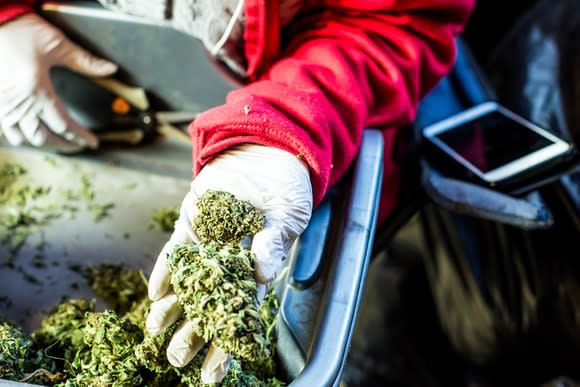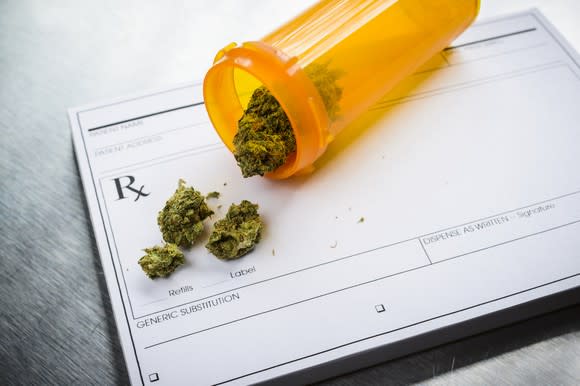The 3 Biggest Problems With Marijuana's Schedule I Classification
Practically everywhere you look, legal cannabis is expanding at a breakneck pace. For instance, Canada passed the Cannabis Act (officially bill C-45) on June 19, setting up Oct. 17 to be the first day that adults can legally purchase recreational weed. Canada is also the first industrialized country in the world to have given the green light to adult-use cannabis.
South of the border, Mexico wound up legalizing medical cannabis in June 2017. It's worth pointing out that Mexico is among more than two dozen foreign countries to have legalized medical marijuana -- and many of these markets will be counting on Canada to supply their product needs.

Image source: Getty Images.
As a Schedule I drug, marijuana businesses and medical patients face a number of hurdles
But when it comes to the United States, we're going nowhere fast, at least at the federal level. Despite 30 states having passed broad-sweeping medical cannabis laws since 1996, including nine states that also allow adults to consume recreational pot, the federal government has stood firm on its view of marijuana as a Schedule I substance.
According to the U.S. Drug Enforcement Agency (DEA), Schedule I substances are "defined as drugs with no currently accepted medical use and a high potential for abuse." Its website lists marijuana, heroin, LSD, peyote, ecstasy, and Quaalude, as Schedule I substances, while drugs like cocaine and methamphetamine are actually found in the slightly less-restrictive Schedule II classification.
Though the federal government has thus far been willing to take a hands-off approach with regard to the expansion of cannabis at the state-level (with the exception of Attorney General Jeff Sessions, who's attempted to wage war on the weed industry), its scheduling has nonetheless created major headaches for the industry. There are, in particular, three major issues that arise for marijuana companies and medical patients as a result of its Schedule I classification.

Image source: Getty Images.
1. Little or no access to basic banking services
The first problem created by the DEA's scheduling of marijuana is that businesses involved in the space are often unable to obtain basic banking services, which includes everything from loans and lines of credit, to some as simple as a checking or savings account. Having to deal solely in cash is an inhibitor of growth and a natural safety hazard since it increases the risk of theft.
The issue is this: financial institutions report to the Federal Deposit Insurance Corporation (FDIC), and the FDIC is a federally created entity, which is bound by federal law. Under a strict interpretation of federal law, banks that offer any scope of financial services to medical or recreational cannabis companies could be construed as laundering money. Ultimately, that could subject banks to monetary and/or criminal penalties.
Now, the good news is the federal government hasn't really cared all that much about whether or not banks are offering their services to cannabis companies. But that could change with Jeff Sessions leading the crusade against cannabis. Since Sessions has been defeated in every attempt to repeal the Rohrabacher-Farr Amendment (also known as Rohrabacher-Blumenauer), which protects medical marijuana businesses in legal states from federal prosecution, he may turn his attention to other areas, such as industry financing.
It's also worth pointing out that while some lawmakers have attempted to open access to financial institutions for cannabis companies in legal states, the Senate Appropriations Committee recently blocked a vote (21 to 10) on a cannabis banking measure.

Image source: Getty Images.
2. Unfair federal tax treatment because of an archaic law
Secondly, U.S. cannabis businesses that happen to be profitable are plagued by an archaic tax law that was developed more than 35 years ago to disrupt businesses that might have been trafficking Schedule I or II substances. Known as Section 280E (officially, Expenditures in connection with the illegal sale of drugs):
No deduction or credit shall be allowed for any amount paid or incurred during the taxable year in carrying on any trade or business if such trade of business (or the activities which comprise such trade of business) consists of trafficking in controlled substances (within the meaning of Schedule I and II of the Controlled Substances Act) which is prohibited by federal law or the law of any state in which such trade or business is conducted.
In plainer English, pot-based businesses are unable to take many of the corporate deductions that normal businesses are. This leaves profitable cannabis companies to pay effective tax rates that could be as high as 70% to 90%. So, essentially, the federal government won't allow the legal weed industry to thrive, but it has no qualms about taxing corporate cannabis income at an exceptionally high rate, thanks to 280E.
Between a lack of access to basic banking services and exorbitant tax rates, it's amazing the U.S. pot industry has the capital to expand or hire at all.

Image source: Getty Images.
3. Red tape impeding medical marijuana research
A final problem is what the DEA's scheduling does to those patients who having aspirations of being treated by medical cannabis or its cannabinoids. Since marijuana is illegal at the federal level, there is no shortage of red tape involved when it comes to running clinical trials that would examine the benefits and risks of cannabis. This red tape means that some studies wait a lot time to get started, or that they may not even be conducted at all.
Beyond red tape, there are genuine supply concerns. There's only one approved federal grow facility in the U.S., located at the University of Mississippi. This single grow site simply doesn't produce enough cannabis to satiate the desire of researchers to run clinical testing.
In 2016, under the Obama administration, it looked as if progress was finally going to be made on the medical front. The administration announced that new grow sites would be added in the future to accommodate additional medical research. However, this expansion hasn't taken shape during the Trump presidency. Despite receiving 25 applications for new federal grow sites last year, Sessions hasn't approved any of them.

Image source: Getty Images.
All hope isn't lost
If there is a silver lining to all of this (or perhaps I should say "green shoot"), it's that there are two catalysts that could lead to a rescheduling of marijuana at the federal level.
First, there's the fact that Americans of all ages and party affiliations strongly favor the idea of legalizing medical marijuana. In April, the independent Quinnipiac University released a poll showing that 93% of respondents were in favor of physicians prescribing medical cannabis to patients. This included 91% of seniors aged 65 and over, as well as 86% of all self-identified Republicans. Seniors and the GOP are traditionally the strongest opponents toward the expansion of weed.
Second, there's the recent approval of cannabinoid-based drug Epidiolex, which was developed by GW Pharmaceuticals (NASDAQ: GWPH). Utilizing the cannabinoid CBD (cannabidiol), GW Pharmaceuticals' lead drug dazzled in clinical trials by reducing seizure frequency from baseline, and relative to the placebo, in two rare forms of childhood-onset epilepsy – Dravet syndrome and Lennox-Gastaut syndrome. The mere fact that GW Pharmaceuticals was able to take cannabinoids from the cannabis plant and turn it into a workable therapeutic puts the Food and Drug Administration's decision to approve this drug in direct conflict with the DEA's definition of a Schedule I drug.
In other words, public opinion and the approval of Epidiolex could incite reform, or at least a more thorough review of medical marijuana, in the very near future.
More From The Motley Fool
Sean Williams has no position in any of the stocks mentioned. The Motley Fool has no position in any of the stocks mentioned. The Motley Fool has a disclosure policy.

 Yahoo Finance
Yahoo Finance 